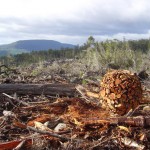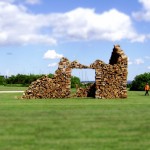Digital Litter 2008
Steel – Welded and naturally weathered
1800mm x 50mtr x 40mtr.
University of Western Sydney – Aquisitive Prize Winner 2008
Statement
For millennia artists have coded stories that future civilisations attempt to decipher. Cuneiform markings in stone tablets, calligraphic quill strokes on parchment, pictograms in the earth – and today we have digital photons of energy coursing through concrete, glass and our own bodies at the speed of light….
Zeros and ones are transmitted in encrypted combinations – to be unraveled in nano seconds by receiving devices thousands of kilometres away. Unanswered messages course through the universe, coded. Where do they end up? These electromagnetic ramblings may never be deciphered; but we can be sure that we are being surrounded by digital litter.
“The 2008 University of Western Sydney Sculpture Prize included Landcom’s acquisitive prize, which was won by Marcus Tatton for his work Digital Litter. Tasmania’s Tatton beat 22 other finalists from across Australia to claim the coveted $20,000 cash prize.
—————————————
Digital Litter is a response to standing next to mobile phone users while I myself do not use one. I liken the process of public mobile use today to that of the public cigarette smoker of the 1960s,” said Tatton. “They are sold as glamorous, but mobiles radiate electromagnetic microwaves and are polluting our immediate environment. The art piece functions on several perception levels. It holds intrigue visually because it is an unexpected composition of objects in the landscape and the digital age reference is a contemporary notion, yet without definition. It is an intriguing conceptual thing…raising questions about the unseen.
“Of course the forms can be played with physically too” he added.
“Digital Litter works to transform the space and allows park users to interact with the art sculpture. Landcom’s ongoing involvement with the University of Western Sydney’s Sculpture Prize reflects the company’s commitment to art in public places.
Landcom sees public art as an important part of community building and believes it gives new areas a cultural identity. Art creates a sense of place in growth areas.”


